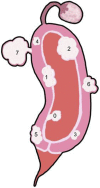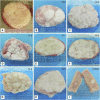Uterine fibroids - Causes, impact, treatment, and lens to the African perspective
- PMID: 36703761
- PMCID: PMC9871264
- DOI: 10.3389/fphar.2022.1045783
Uterine fibroids - Causes, impact, treatment, and lens to the African perspective
Abstract
Leiomyomas, or uterine fibroids as they are commonly known, are mostly seen in women of reproductive age. However, they can go undetected in most women, and approximately 25% of women show clinical symptoms. Although fibroids are a global burden impacting 80% of premenopausal women, they are more prevalent among Black women than among women of other races. Based on clinical diagnosis, the estimated cumulative incidence of fibroids in women ≤50 years old is significantly higher for black (>80%) versus white women (∼70%). The cause of leiomyomas is not clearly known, but studies have shown evidence of factors that drive the development or exacerbation of the disease. Evidence has linked risk factors such as lifestyle, age, environment, family history of uterine fibroids, and vitamin D deficiencies to an increased risk of uterine fibroids, which impact women of African descent at higher rates. Treatments may be invasive, such as hysterectomy and myomectomy, or non-invasive, such as hormonal or non-hormonal therapies. These treatments are costly and tend to burden women who have the disease. Sub-Saharan Africa is known to have the largest population of black women, yet the majority of uterine fibroid studies do not include populations from the continent. Furthermore, the prevalence of the disease on the continent is not well determined. To effectively treat the disease, its drivers need to be understood, especially with regard to racial preferences. This paper aims to review the existing literature and build a case for conducting future research on African women.
Keywords: Africa; causes and treatment; fibroid; lifestyle; perspective; race; types and classification.
Copyright © 2023 Sefah, Ndebele, Prince, Korasare, Agbleke, Nkansah, Thompson, Al-Hendy and Agbleke.
Conflict of interest statement
The authors declare that the research was conducted in the absence of any commercial or financial relationships that could be construed as a potential conflict of interest.
Figures





Similar articles
-
The management of uterine leiomyomas.J Obstet Gynaecol Can. 2015 Feb;37(2):157-178. doi: 10.1016/S1701-2163(15)30338-8. J Obstet Gynaecol Can. 2015. PMID: 25767949
-
The Comparing Options for Management: PAtient-centered REsults for Uterine Fibroids (COMPARE-UF) registry: rationale and design.Am J Obstet Gynecol. 2018 Jul;219(1):95.e1-95.e10. doi: 10.1016/j.ajog.2018.05.004. Epub 2018 May 8. Am J Obstet Gynecol. 2018. PMID: 29750955 Free PMC article.
-
Uterine artery embolisation versus myomectomy for premenopausal women with uterine fibroids wishing to avoid hysterectomy: the FEMME RCT.Health Technol Assess. 2022 Apr;26(22):1-74. doi: 10.3310/ZDEG6110. Health Technol Assess. 2022. PMID: 35435818 Free PMC article. Clinical Trial.
-
The role of socioeconomic status in uterine fibroid awareness and treatment: a narrative review.Ther Adv Reprod Health. 2024 Nov 9;18:26334941241297634. doi: 10.1177/26334941241297634. eCollection 2024 Jan-Dec. Ther Adv Reprod Health. 2024. PMID: 39525322 Free PMC article. Review.
-
Uterine fibroid management: from the present to the future.Hum Reprod Update. 2016 Nov;22(6):665-686. doi: 10.1093/humupd/dmw023. Epub 2016 Jul 27. Hum Reprod Update. 2016. PMID: 27466209 Free PMC article. Review.
Cited by
-
The experiences of women diagnosed with uterine fibroids in the Kingdom of Eswatini.Health SA. 2024 Nov 15;29:2724. doi: 10.4102/hsag.v29i0.2724. eCollection 2024. Health SA. 2024. PMID: 39649347 Free PMC article.
-
Minimally Invasive Myomectomy: A Systematic Review of Techniques, Challenges, and Fertility Outcomes.Cureus. 2025 Jun 2;17(6):e85246. doi: 10.7759/cureus.85246. eCollection 2025 Jun. Cureus. 2025. PMID: 40605867 Free PMC article. Review.
-
Uterine Fibroids: A Podcast on Patient and Physician Perspectives on Medical Management and a New Medical Therapy (Relugolix Combination Therapy).Adv Ther. 2023 Oct;40(10):4127-4133. doi: 10.1007/s12325-023-02595-x. Epub 2023 Aug 12. Adv Ther. 2023. PMID: 37568061 Free PMC article.
-
Laparoscopic Enucleation of a Cervical Myoma and Reconstruction of Cervical Canal.Gynecol Minim Invasive Ther. 2025 Feb 27;14(1):96-97. doi: 10.4103/gmit.gmit_34_24. eCollection 2025 Jan-Mar. Gynecol Minim Invasive Ther. 2025. PMID: 40143980 Free PMC article. No abstract available.
-
Development of a high-performing, cost-effective and inclusive Afrocentric predictive model for stroke: a meta-analysis approach.BMC Neurol. 2025 Jul 7;25(1):282. doi: 10.1186/s12883-025-04229-x. BMC Neurol. 2025. PMID: 40624481 Free PMC article.
References
-
- Abdelmtalab M. A. A., Tahir O., Hussein K., Badawi K. (2020). Anatomical locations of uterine fibroids in Sudanese women. Anat. J. Afr. 9 (1), 1701–1706. 10.4314/aja.v9i1.6 - DOI
-
- Adawe M., Sezalio M., Kanyesigye H., Kajabwangu R., Okello S., Bajunirwe F., et al. (2022). Prevalence, clinical presentation and factors associated with Uterine fibroids among women attending the Gynecology Outpatient Department at a large Referral Hospital in Southwestern Uganda. East Afr. Sci. 4 (1), 38–53. 10.24248/easci.v4i1.58 - DOI
-
- Adisso S., Hounsossou H., Alle I. R., Adisso E. L., Takpara L., Alihonou E. (2014). Quelle issue pour la grossesse jeun dans un uterus myomateux. JBC 21, 13
-
- Akinola O. I., Ottun T. A., Fabamwo A. O., Akinniyi A. O. (2003). Bilateral uterine artery ligation: An effective low-technology option in the management of symptomatic uterine fibroids. Trop. J. Obstetrics Gynaecol. 20 (1), 4–6. 10.4314/tjog.v20i1.14389 - DOI
Publication types
LinkOut - more resources
Full Text Sources

